HRM Report: Learning Styles, Training Methods, and Government Role
VerifiedAdded on 2020/07/22
|16
|5271
|30
Report
AI Summary
This report on Human Resource Development (HRD) analyzes various aspects of employee training and development within the context of Sun Court Limited, a UK-based residential care provider. It begins by comparing different learning styles, including Kolb's model, Honey and Mumford's model, and the VAK/VARK model, highlighting their application in the workplace. The report then explores the role and importance of learning curves in decision-making, workforce scheduling, and performance monitoring. Furthermore, it examines the contribution of learning styles and theories in planning and designing effective training events. The report also delves into the government's role in training, development, and lifelong learning, as well as the influence of the development competency movement on both public and private sectors. It further explores the impact of training on employee performance and the importance of appropriate training methods, and the systematic approach to preparing training and development plans. The report concludes with an evaluation of training programs, including evaluation techniques, evaluation of training events, and appraisal of the success of the evaluation methods.
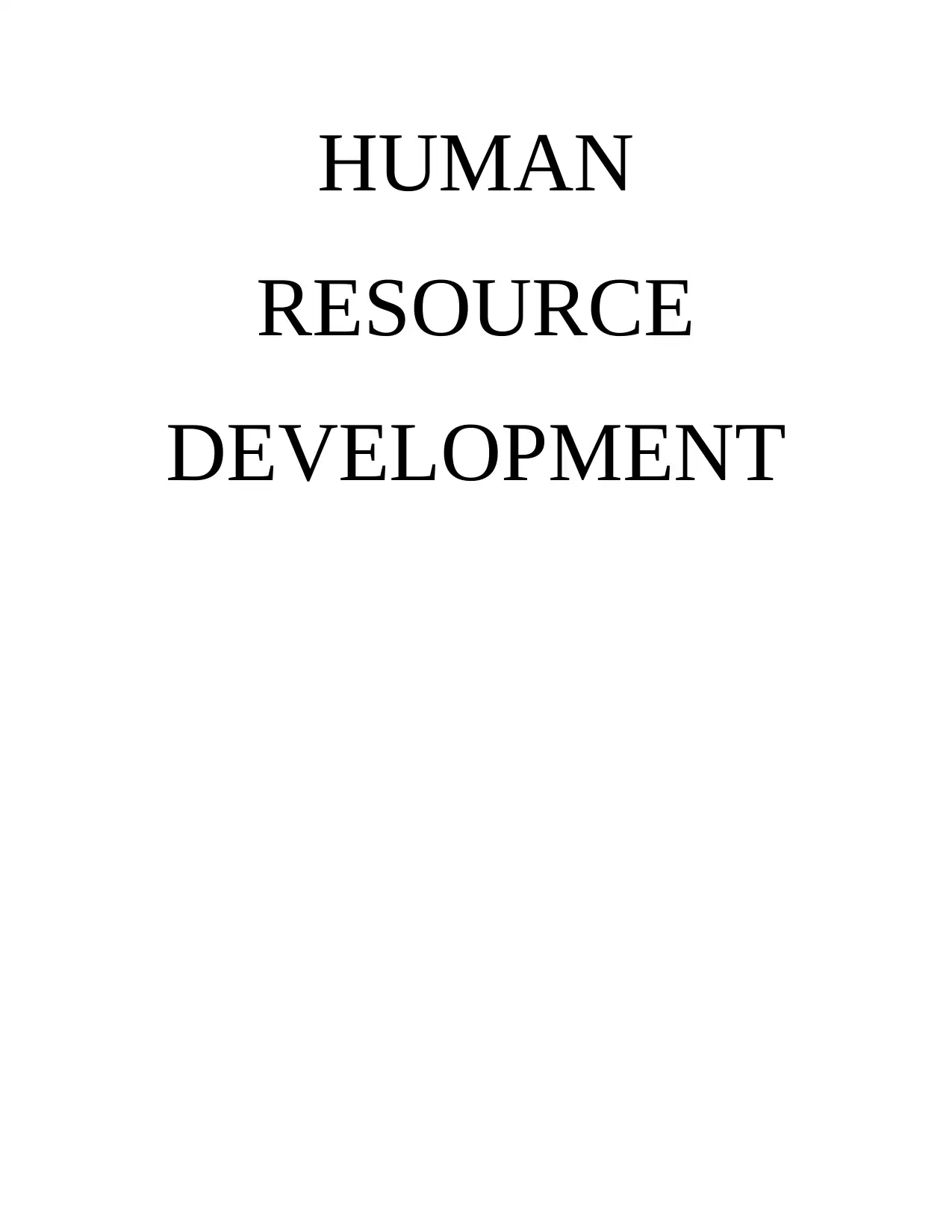
HUMAN
RESOURCE
DEVELOPMENT
RESOURCE
DEVELOPMENT
Paraphrase This Document
Need a fresh take? Get an instant paraphrase of this document with our AI Paraphraser
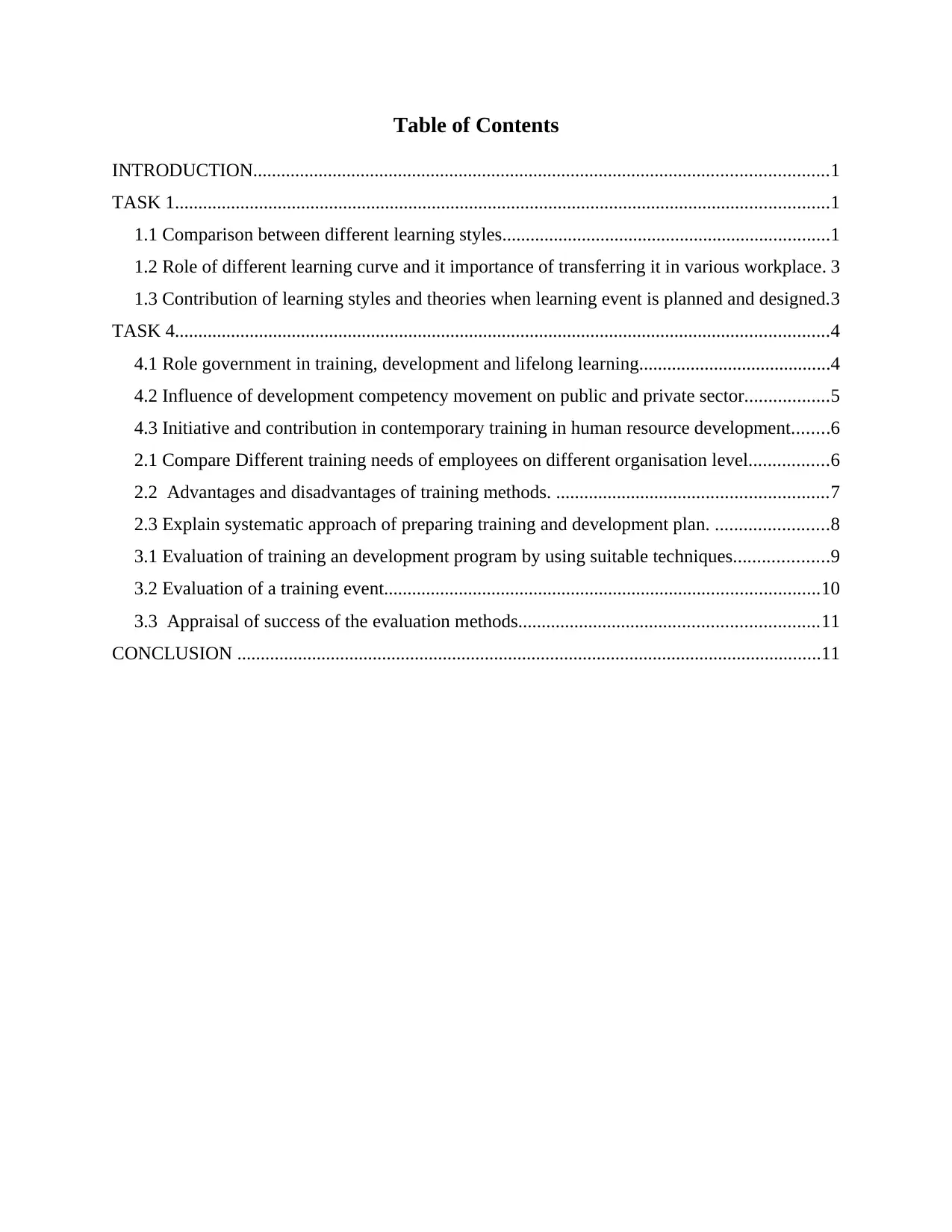
Table of Contents
INTRODUCTION...........................................................................................................................1
TASK 1............................................................................................................................................1
1.1 Comparison between different learning styles......................................................................1
1.2 Role of different learning curve and it importance of transferring it in various workplace. 3
1.3 Contribution of learning styles and theories when learning event is planned and designed.3
TASK 4............................................................................................................................................4
4.1 Role government in training, development and lifelong learning.........................................4
4.2 Influence of development competency movement on public and private sector..................5
4.3 Initiative and contribution in contemporary training in human resource development........6
2.1 Compare Different training needs of employees on different organisation level.................6
2.2 Advantages and disadvantages of training methods. ..........................................................7
2.3 Explain systematic approach of preparing training and development plan. ........................8
3.1 Evaluation of training an development program by using suitable techniques....................9
3.2 Evaluation of a training event.............................................................................................10
3.3 Appraisal of success of the evaluation methods................................................................11
CONCLUSION .............................................................................................................................11
INTRODUCTION...........................................................................................................................1
TASK 1............................................................................................................................................1
1.1 Comparison between different learning styles......................................................................1
1.2 Role of different learning curve and it importance of transferring it in various workplace. 3
1.3 Contribution of learning styles and theories when learning event is planned and designed.3
TASK 4............................................................................................................................................4
4.1 Role government in training, development and lifelong learning.........................................4
4.2 Influence of development competency movement on public and private sector..................5
4.3 Initiative and contribution in contemporary training in human resource development........6
2.1 Compare Different training needs of employees on different organisation level.................6
2.2 Advantages and disadvantages of training methods. ..........................................................7
2.3 Explain systematic approach of preparing training and development plan. ........................8
3.1 Evaluation of training an development program by using suitable techniques....................9
3.2 Evaluation of a training event.............................................................................................10
3.3 Appraisal of success of the evaluation methods................................................................11
CONCLUSION .............................................................................................................................11

You're viewing a preview
Unlock full access by subscribing today!
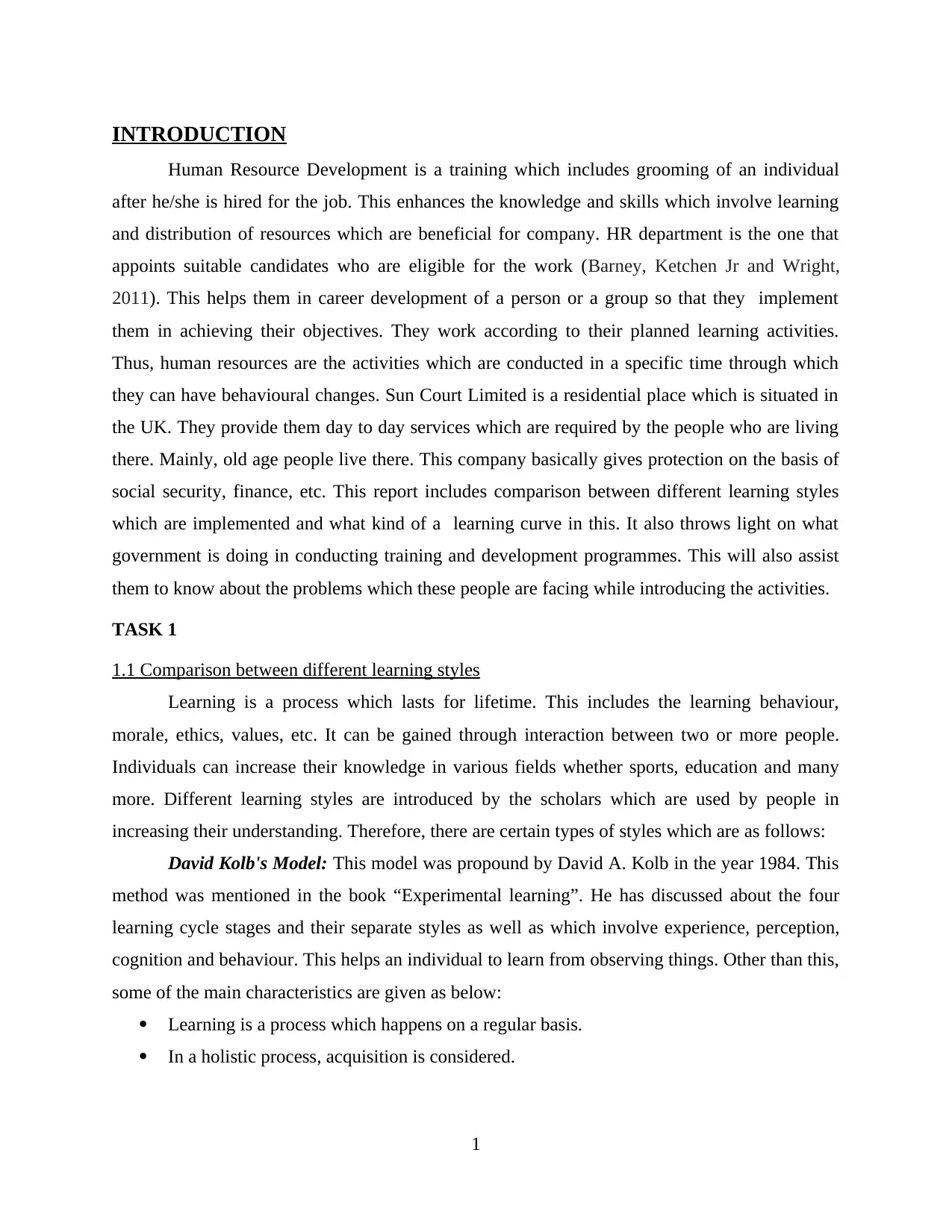
INTRODUCTION
Human Resource Development is a training which includes grooming of an individual
after he/she is hired for the job. This enhances the knowledge and skills which involve learning
and distribution of resources which are beneficial for company. HR department is the one that
appoints suitable candidates who are eligible for the work (Barney, Ketchen Jr and Wright,
2011). This helps them in career development of a person or a group so that they implement
them in achieving their objectives. They work according to their planned learning activities.
Thus, human resources are the activities which are conducted in a specific time through which
they can have behavioural changes. Sun Court Limited is a residential place which is situated in
the UK. They provide them day to day services which are required by the people who are living
there. Mainly, old age people live there. This company basically gives protection on the basis of
social security, finance, etc. This report includes comparison between different learning styles
which are implemented and what kind of a learning curve in this. It also throws light on what
government is doing in conducting training and development programmes. This will also assist
them to know about the problems which these people are facing while introducing the activities.
TASK 1
1.1 Comparison between different learning styles
Learning is a process which lasts for lifetime. This includes the learning behaviour,
morale, ethics, values, etc. It can be gained through interaction between two or more people.
Individuals can increase their knowledge in various fields whether sports, education and many
more. Different learning styles are introduced by the scholars which are used by people in
increasing their understanding. Therefore, there are certain types of styles which are as follows:
David Kolb's Model: This model was propound by David A. Kolb in the year 1984. This
method was mentioned in the book “Experimental learning”. He has discussed about the four
learning cycle stages and their separate styles as well as which involve experience, perception,
cognition and behaviour. This helps an individual to learn from observing things. Other than this,
some of the main characteristics are given as below:
Learning is a process which happens on a regular basis.
In a holistic process, acquisition is considered.
1
Human Resource Development is a training which includes grooming of an individual
after he/she is hired for the job. This enhances the knowledge and skills which involve learning
and distribution of resources which are beneficial for company. HR department is the one that
appoints suitable candidates who are eligible for the work (Barney, Ketchen Jr and Wright,
2011). This helps them in career development of a person or a group so that they implement
them in achieving their objectives. They work according to their planned learning activities.
Thus, human resources are the activities which are conducted in a specific time through which
they can have behavioural changes. Sun Court Limited is a residential place which is situated in
the UK. They provide them day to day services which are required by the people who are living
there. Mainly, old age people live there. This company basically gives protection on the basis of
social security, finance, etc. This report includes comparison between different learning styles
which are implemented and what kind of a learning curve in this. It also throws light on what
government is doing in conducting training and development programmes. This will also assist
them to know about the problems which these people are facing while introducing the activities.
TASK 1
1.1 Comparison between different learning styles
Learning is a process which lasts for lifetime. This includes the learning behaviour,
morale, ethics, values, etc. It can be gained through interaction between two or more people.
Individuals can increase their knowledge in various fields whether sports, education and many
more. Different learning styles are introduced by the scholars which are used by people in
increasing their understanding. Therefore, there are certain types of styles which are as follows:
David Kolb's Model: This model was propound by David A. Kolb in the year 1984. This
method was mentioned in the book “Experimental learning”. He has discussed about the four
learning cycle stages and their separate styles as well as which involve experience, perception,
cognition and behaviour. This helps an individual to learn from observing things. Other than this,
some of the main characteristics are given as below:
Learning is a process which happens on a regular basis.
In a holistic process, acquisition is considered.
1
Paraphrase This Document
Need a fresh take? Get an instant paraphrase of this document with our AI Paraphraser
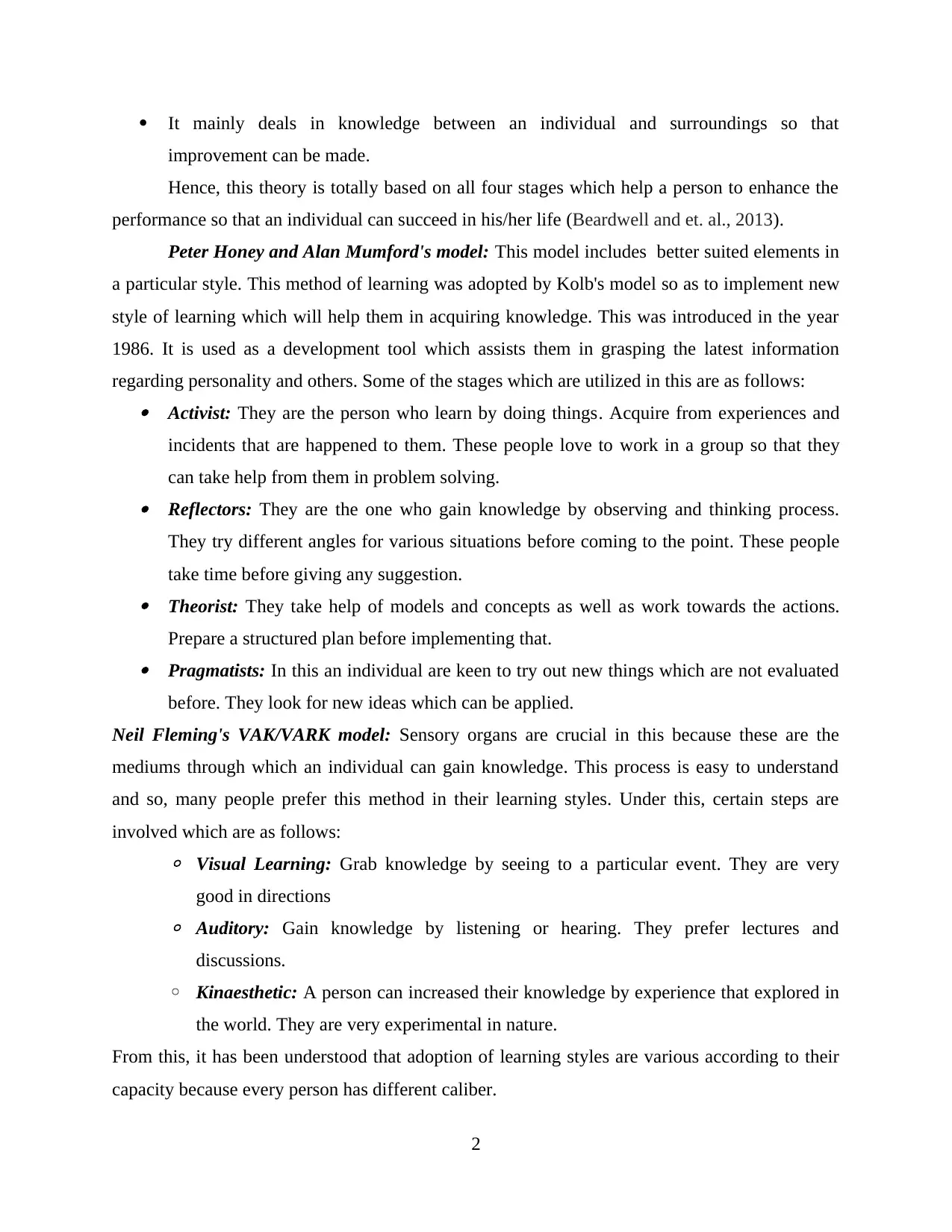
It mainly deals in knowledge between an individual and surroundings so that
improvement can be made.
Hence, this theory is totally based on all four stages which help a person to enhance the
performance so that an individual can succeed in his/her life (Beardwell and et. al., 2013).
Peter Honey and Alan Mumford's model: This model includes better suited elements in
a particular style. This method of learning was adopted by Kolb's model so as to implement new
style of learning which will help them in acquiring knowledge. This was introduced in the year
1986. It is used as a development tool which assists them in grasping the latest information
regarding personality and others. Some of the stages which are utilized in this are as follows: Activist: They are the person who learn by doing things. Acquire from experiences and
incidents that are happened to them. These people love to work in a group so that they
can take help from them in problem solving. Reflectors: They are the one who gain knowledge by observing and thinking process.
They try different angles for various situations before coming to the point. These people
take time before giving any suggestion. Theorist: They take help of models and concepts as well as work towards the actions.
Prepare a structured plan before implementing that. Pragmatists: In this an individual are keen to try out new things which are not evaluated
before. They look for new ideas which can be applied.
Neil Fleming's VAK/VARK model: Sensory organs are crucial in this because these are the
mediums through which an individual can gain knowledge. This process is easy to understand
and so, many people prefer this method in their learning styles. Under this, certain steps are
involved which are as follows:
◦ Visual Learning: Grab knowledge by seeing to a particular event. They are very
good in directions
◦ Auditory: Gain knowledge by listening or hearing. They prefer lectures and
discussions.
◦ Kinaesthetic: A person can increased their knowledge by experience that explored in
the world. They are very experimental in nature.
From this, it has been understood that adoption of learning styles are various according to their
capacity because every person has different caliber.
2
improvement can be made.
Hence, this theory is totally based on all four stages which help a person to enhance the
performance so that an individual can succeed in his/her life (Beardwell and et. al., 2013).
Peter Honey and Alan Mumford's model: This model includes better suited elements in
a particular style. This method of learning was adopted by Kolb's model so as to implement new
style of learning which will help them in acquiring knowledge. This was introduced in the year
1986. It is used as a development tool which assists them in grasping the latest information
regarding personality and others. Some of the stages which are utilized in this are as follows: Activist: They are the person who learn by doing things. Acquire from experiences and
incidents that are happened to them. These people love to work in a group so that they
can take help from them in problem solving. Reflectors: They are the one who gain knowledge by observing and thinking process.
They try different angles for various situations before coming to the point. These people
take time before giving any suggestion. Theorist: They take help of models and concepts as well as work towards the actions.
Prepare a structured plan before implementing that. Pragmatists: In this an individual are keen to try out new things which are not evaluated
before. They look for new ideas which can be applied.
Neil Fleming's VAK/VARK model: Sensory organs are crucial in this because these are the
mediums through which an individual can gain knowledge. This process is easy to understand
and so, many people prefer this method in their learning styles. Under this, certain steps are
involved which are as follows:
◦ Visual Learning: Grab knowledge by seeing to a particular event. They are very
good in directions
◦ Auditory: Gain knowledge by listening or hearing. They prefer lectures and
discussions.
◦ Kinaesthetic: A person can increased their knowledge by experience that explored in
the world. They are very experimental in nature.
From this, it has been understood that adoption of learning styles are various according to their
capacity because every person has different caliber.
2
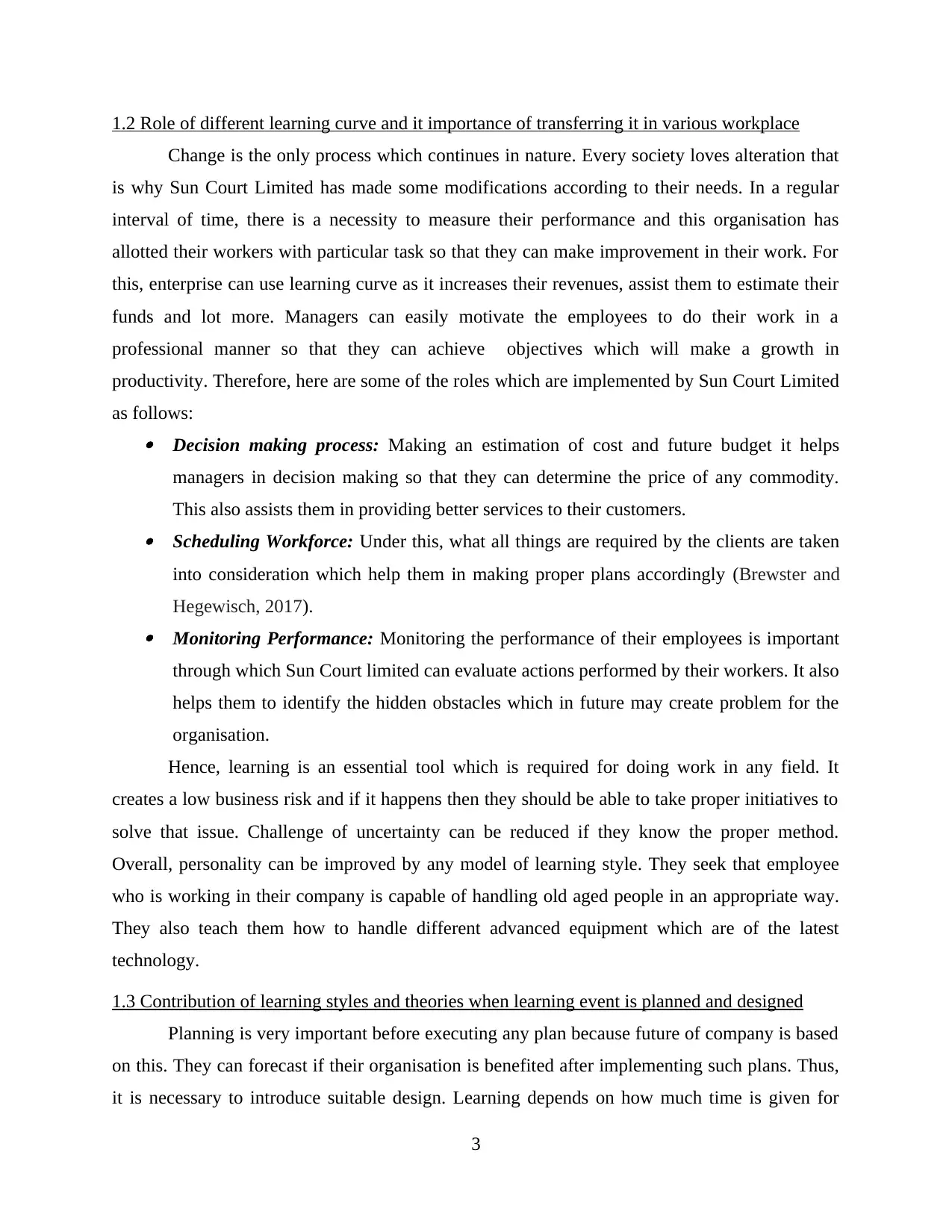
1.2 Role of different learning curve and it importance of transferring it in various workplace
Change is the only process which continues in nature. Every society loves alteration that
is why Sun Court Limited has made some modifications according to their needs. In a regular
interval of time, there is a necessity to measure their performance and this organisation has
allotted their workers with particular task so that they can make improvement in their work. For
this, enterprise can use learning curve as it increases their revenues, assist them to estimate their
funds and lot more. Managers can easily motivate the employees to do their work in a
professional manner so that they can achieve objectives which will make a growth in
productivity. Therefore, here are some of the roles which are implemented by Sun Court Limited
as follows: Decision making process: Making an estimation of cost and future budget it helps
managers in decision making so that they can determine the price of any commodity.
This also assists them in providing better services to their customers. Scheduling Workforce: Under this, what all things are required by the clients are taken
into consideration which help them in making proper plans accordingly (Brewster and
Hegewisch, 2017). Monitoring Performance: Monitoring the performance of their employees is important
through which Sun Court limited can evaluate actions performed by their workers. It also
helps them to identify the hidden obstacles which in future may create problem for the
organisation.
Hence, learning is an essential tool which is required for doing work in any field. It
creates a low business risk and if it happens then they should be able to take proper initiatives to
solve that issue. Challenge of uncertainty can be reduced if they know the proper method.
Overall, personality can be improved by any model of learning style. They seek that employee
who is working in their company is capable of handling old aged people in an appropriate way.
They also teach them how to handle different advanced equipment which are of the latest
technology.
1.3 Contribution of learning styles and theories when learning event is planned and designed
Planning is very important before executing any plan because future of company is based
on this. They can forecast if their organisation is benefited after implementing such plans. Thus,
it is necessary to introduce suitable design. Learning depends on how much time is given for
3
Change is the only process which continues in nature. Every society loves alteration that
is why Sun Court Limited has made some modifications according to their needs. In a regular
interval of time, there is a necessity to measure their performance and this organisation has
allotted their workers with particular task so that they can make improvement in their work. For
this, enterprise can use learning curve as it increases their revenues, assist them to estimate their
funds and lot more. Managers can easily motivate the employees to do their work in a
professional manner so that they can achieve objectives which will make a growth in
productivity. Therefore, here are some of the roles which are implemented by Sun Court Limited
as follows: Decision making process: Making an estimation of cost and future budget it helps
managers in decision making so that they can determine the price of any commodity.
This also assists them in providing better services to their customers. Scheduling Workforce: Under this, what all things are required by the clients are taken
into consideration which help them in making proper plans accordingly (Brewster and
Hegewisch, 2017). Monitoring Performance: Monitoring the performance of their employees is important
through which Sun Court limited can evaluate actions performed by their workers. It also
helps them to identify the hidden obstacles which in future may create problem for the
organisation.
Hence, learning is an essential tool which is required for doing work in any field. It
creates a low business risk and if it happens then they should be able to take proper initiatives to
solve that issue. Challenge of uncertainty can be reduced if they know the proper method.
Overall, personality can be improved by any model of learning style. They seek that employee
who is working in their company is capable of handling old aged people in an appropriate way.
They also teach them how to handle different advanced equipment which are of the latest
technology.
1.3 Contribution of learning styles and theories when learning event is planned and designed
Planning is very important before executing any plan because future of company is based
on this. They can forecast if their organisation is benefited after implementing such plans. Thus,
it is necessary to introduce suitable design. Learning depends on how much time is given for
3
You're viewing a preview
Unlock full access by subscribing today!
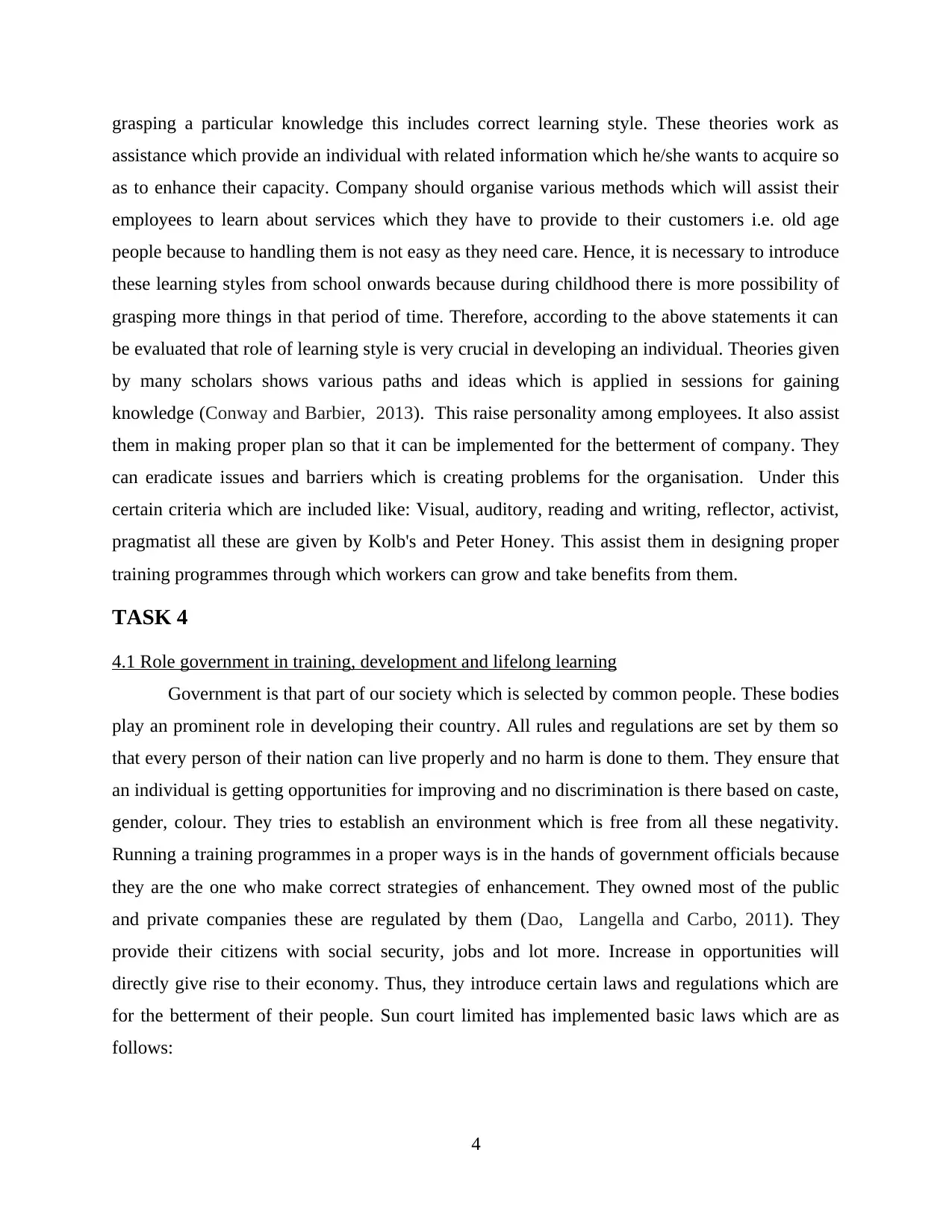
grasping a particular knowledge this includes correct learning style. These theories work as
assistance which provide an individual with related information which he/she wants to acquire so
as to enhance their capacity. Company should organise various methods which will assist their
employees to learn about services which they have to provide to their customers i.e. old age
people because to handling them is not easy as they need care. Hence, it is necessary to introduce
these learning styles from school onwards because during childhood there is more possibility of
grasping more things in that period of time. Therefore, according to the above statements it can
be evaluated that role of learning style is very crucial in developing an individual. Theories given
by many scholars shows various paths and ideas which is applied in sessions for gaining
knowledge (Conway and Barbier, 2013). This raise personality among employees. It also assist
them in making proper plan so that it can be implemented for the betterment of company. They
can eradicate issues and barriers which is creating problems for the organisation. Under this
certain criteria which are included like: Visual, auditory, reading and writing, reflector, activist,
pragmatist all these are given by Kolb's and Peter Honey. This assist them in designing proper
training programmes through which workers can grow and take benefits from them.
TASK 4
4.1 Role government in training, development and lifelong learning
Government is that part of our society which is selected by common people. These bodies
play an prominent role in developing their country. All rules and regulations are set by them so
that every person of their nation can live properly and no harm is done to them. They ensure that
an individual is getting opportunities for improving and no discrimination is there based on caste,
gender, colour. They tries to establish an environment which is free from all these negativity.
Running a training programmes in a proper ways is in the hands of government officials because
they are the one who make correct strategies of enhancement. They owned most of the public
and private companies these are regulated by them (Dao, Langella and Carbo, 2011). They
provide their citizens with social security, jobs and lot more. Increase in opportunities will
directly give rise to their economy. Thus, they introduce certain laws and regulations which are
for the betterment of their people. Sun court limited has implemented basic laws which are as
follows:
4
assistance which provide an individual with related information which he/she wants to acquire so
as to enhance their capacity. Company should organise various methods which will assist their
employees to learn about services which they have to provide to their customers i.e. old age
people because to handling them is not easy as they need care. Hence, it is necessary to introduce
these learning styles from school onwards because during childhood there is more possibility of
grasping more things in that period of time. Therefore, according to the above statements it can
be evaluated that role of learning style is very crucial in developing an individual. Theories given
by many scholars shows various paths and ideas which is applied in sessions for gaining
knowledge (Conway and Barbier, 2013). This raise personality among employees. It also assist
them in making proper plan so that it can be implemented for the betterment of company. They
can eradicate issues and barriers which is creating problems for the organisation. Under this
certain criteria which are included like: Visual, auditory, reading and writing, reflector, activist,
pragmatist all these are given by Kolb's and Peter Honey. This assist them in designing proper
training programmes through which workers can grow and take benefits from them.
TASK 4
4.1 Role government in training, development and lifelong learning
Government is that part of our society which is selected by common people. These bodies
play an prominent role in developing their country. All rules and regulations are set by them so
that every person of their nation can live properly and no harm is done to them. They ensure that
an individual is getting opportunities for improving and no discrimination is there based on caste,
gender, colour. They tries to establish an environment which is free from all these negativity.
Running a training programmes in a proper ways is in the hands of government officials because
they are the one who make correct strategies of enhancement. They owned most of the public
and private companies these are regulated by them (Dao, Langella and Carbo, 2011). They
provide their citizens with social security, jobs and lot more. Increase in opportunities will
directly give rise to their economy. Thus, they introduce certain laws and regulations which are
for the betterment of their people. Sun court limited has implemented basic laws which are as
follows:
4
Paraphrase This Document
Need a fresh take? Get an instant paraphrase of this document with our AI Paraphraser
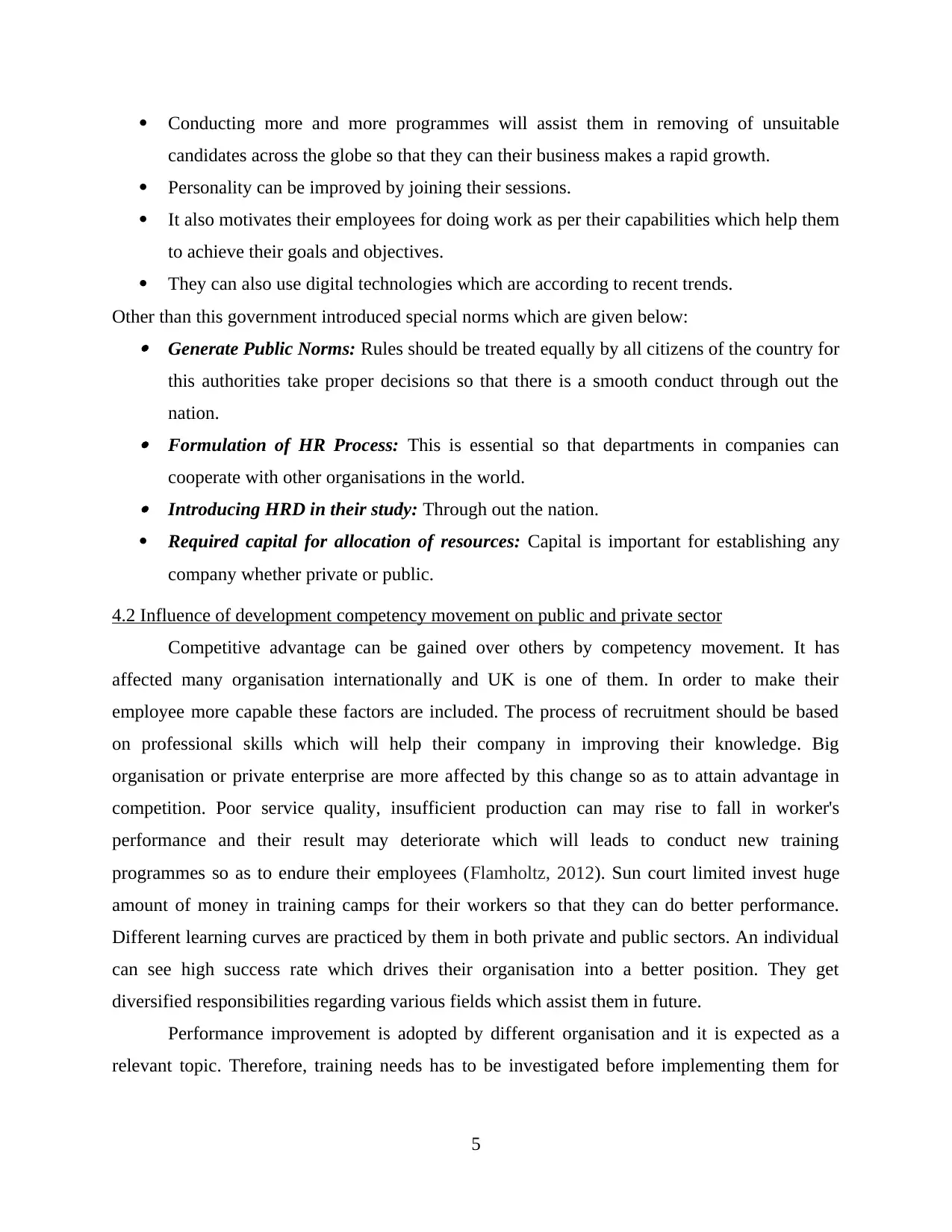
Conducting more and more programmes will assist them in removing of unsuitable
candidates across the globe so that they can their business makes a rapid growth.
Personality can be improved by joining their sessions.
It also motivates their employees for doing work as per their capabilities which help them
to achieve their goals and objectives.
They can also use digital technologies which are according to recent trends.
Other than this government introduced special norms which are given below: Generate Public Norms: Rules should be treated equally by all citizens of the country for
this authorities take proper decisions so that there is a smooth conduct through out the
nation. Formulation of HR Process: This is essential so that departments in companies can
cooperate with other organisations in the world. Introducing HRD in their study: Through out the nation.
Required capital for allocation of resources: Capital is important for establishing any
company whether private or public.
4.2 Influence of development competency movement on public and private sector
Competitive advantage can be gained over others by competency movement. It has
affected many organisation internationally and UK is one of them. In order to make their
employee more capable these factors are included. The process of recruitment should be based
on professional skills which will help their company in improving their knowledge. Big
organisation or private enterprise are more affected by this change so as to attain advantage in
competition. Poor service quality, insufficient production can may rise to fall in worker's
performance and their result may deteriorate which will leads to conduct new training
programmes so as to endure their employees (Flamholtz, 2012). Sun court limited invest huge
amount of money in training camps for their workers so that they can do better performance.
Different learning curves are practiced by them in both private and public sectors. An individual
can see high success rate which drives their organisation into a better position. They get
diversified responsibilities regarding various fields which assist them in future.
Performance improvement is adopted by different organisation and it is expected as a
relevant topic. Therefore, training needs has to be investigated before implementing them for
5
candidates across the globe so that they can their business makes a rapid growth.
Personality can be improved by joining their sessions.
It also motivates their employees for doing work as per their capabilities which help them
to achieve their goals and objectives.
They can also use digital technologies which are according to recent trends.
Other than this government introduced special norms which are given below: Generate Public Norms: Rules should be treated equally by all citizens of the country for
this authorities take proper decisions so that there is a smooth conduct through out the
nation. Formulation of HR Process: This is essential so that departments in companies can
cooperate with other organisations in the world. Introducing HRD in their study: Through out the nation.
Required capital for allocation of resources: Capital is important for establishing any
company whether private or public.
4.2 Influence of development competency movement on public and private sector
Competitive advantage can be gained over others by competency movement. It has
affected many organisation internationally and UK is one of them. In order to make their
employee more capable these factors are included. The process of recruitment should be based
on professional skills which will help their company in improving their knowledge. Big
organisation or private enterprise are more affected by this change so as to attain advantage in
competition. Poor service quality, insufficient production can may rise to fall in worker's
performance and their result may deteriorate which will leads to conduct new training
programmes so as to endure their employees (Flamholtz, 2012). Sun court limited invest huge
amount of money in training camps for their workers so that they can do better performance.
Different learning curves are practiced by them in both private and public sectors. An individual
can see high success rate which drives their organisation into a better position. They get
diversified responsibilities regarding various fields which assist them in future.
Performance improvement is adopted by different organisation and it is expected as a
relevant topic. Therefore, training needs has to be investigated before implementing them for
5
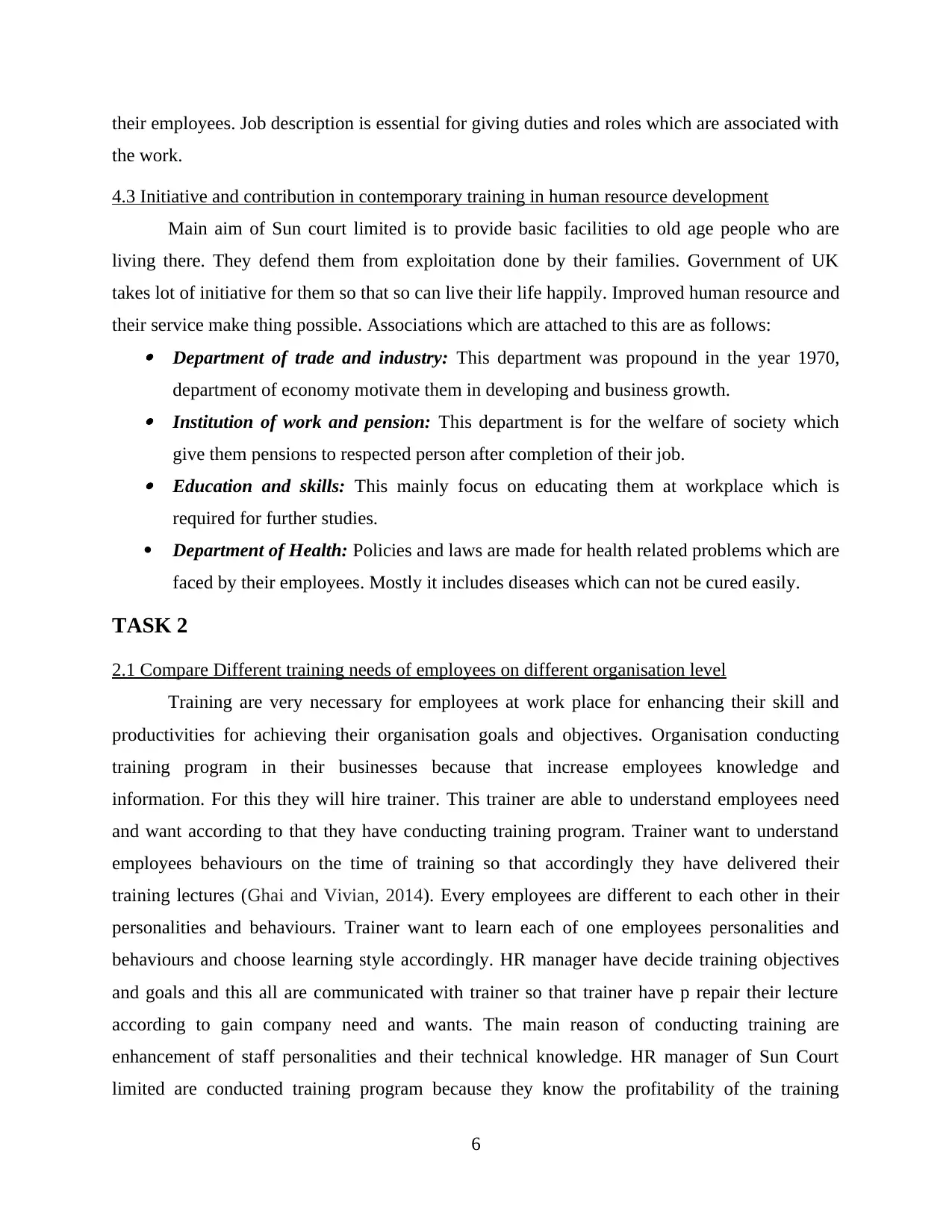
their employees. Job description is essential for giving duties and roles which are associated with
the work.
4.3 Initiative and contribution in contemporary training in human resource development
Main aim of Sun court limited is to provide basic facilities to old age people who are
living there. They defend them from exploitation done by their families. Government of UK
takes lot of initiative for them so that so can live their life happily. Improved human resource and
their service make thing possible. Associations which are attached to this are as follows: Department of trade and industry: This department was propound in the year 1970,
department of economy motivate them in developing and business growth. Institution of work and pension: This department is for the welfare of society which
give them pensions to respected person after completion of their job. Education and skills: This mainly focus on educating them at workplace which is
required for further studies.
Department of Health: Policies and laws are made for health related problems which are
faced by their employees. Mostly it includes diseases which can not be cured easily.
TASK 2
2.1 Compare Different training needs of employees on different organisation level
Training are very necessary for employees at work place for enhancing their skill and
productivities for achieving their organisation goals and objectives. Organisation conducting
training program in their businesses because that increase employees knowledge and
information. For this they will hire trainer. This trainer are able to understand employees need
and want according to that they have conducting training program. Trainer want to understand
employees behaviours on the time of training so that accordingly they have delivered their
training lectures (Ghai and Vivian, 2014). Every employees are different to each other in their
personalities and behaviours. Trainer want to learn each of one employees personalities and
behaviours and choose learning style accordingly. HR manager have decide training objectives
and goals and this all are communicated with trainer so that trainer have p repair their lecture
according to gain company need and wants. The main reason of conducting training are
enhancement of staff personalities and their technical knowledge. HR manager of Sun Court
limited are conducted training program because they know the profitability of the training
6
the work.
4.3 Initiative and contribution in contemporary training in human resource development
Main aim of Sun court limited is to provide basic facilities to old age people who are
living there. They defend them from exploitation done by their families. Government of UK
takes lot of initiative for them so that so can live their life happily. Improved human resource and
their service make thing possible. Associations which are attached to this are as follows: Department of trade and industry: This department was propound in the year 1970,
department of economy motivate them in developing and business growth. Institution of work and pension: This department is for the welfare of society which
give them pensions to respected person after completion of their job. Education and skills: This mainly focus on educating them at workplace which is
required for further studies.
Department of Health: Policies and laws are made for health related problems which are
faced by their employees. Mostly it includes diseases which can not be cured easily.
TASK 2
2.1 Compare Different training needs of employees on different organisation level
Training are very necessary for employees at work place for enhancing their skill and
productivities for achieving their organisation goals and objectives. Organisation conducting
training program in their businesses because that increase employees knowledge and
information. For this they will hire trainer. This trainer are able to understand employees need
and want according to that they have conducting training program. Trainer want to understand
employees behaviours on the time of training so that accordingly they have delivered their
training lectures (Ghai and Vivian, 2014). Every employees are different to each other in their
personalities and behaviours. Trainer want to learn each of one employees personalities and
behaviours and choose learning style accordingly. HR manager have decide training objectives
and goals and this all are communicated with trainer so that trainer have p repair their lecture
according to gain company need and wants. The main reason of conducting training are
enhancement of staff personalities and their technical knowledge. HR manager of Sun Court
limited are conducted training program because they know the profitability of the training
6
You're viewing a preview
Unlock full access by subscribing today!
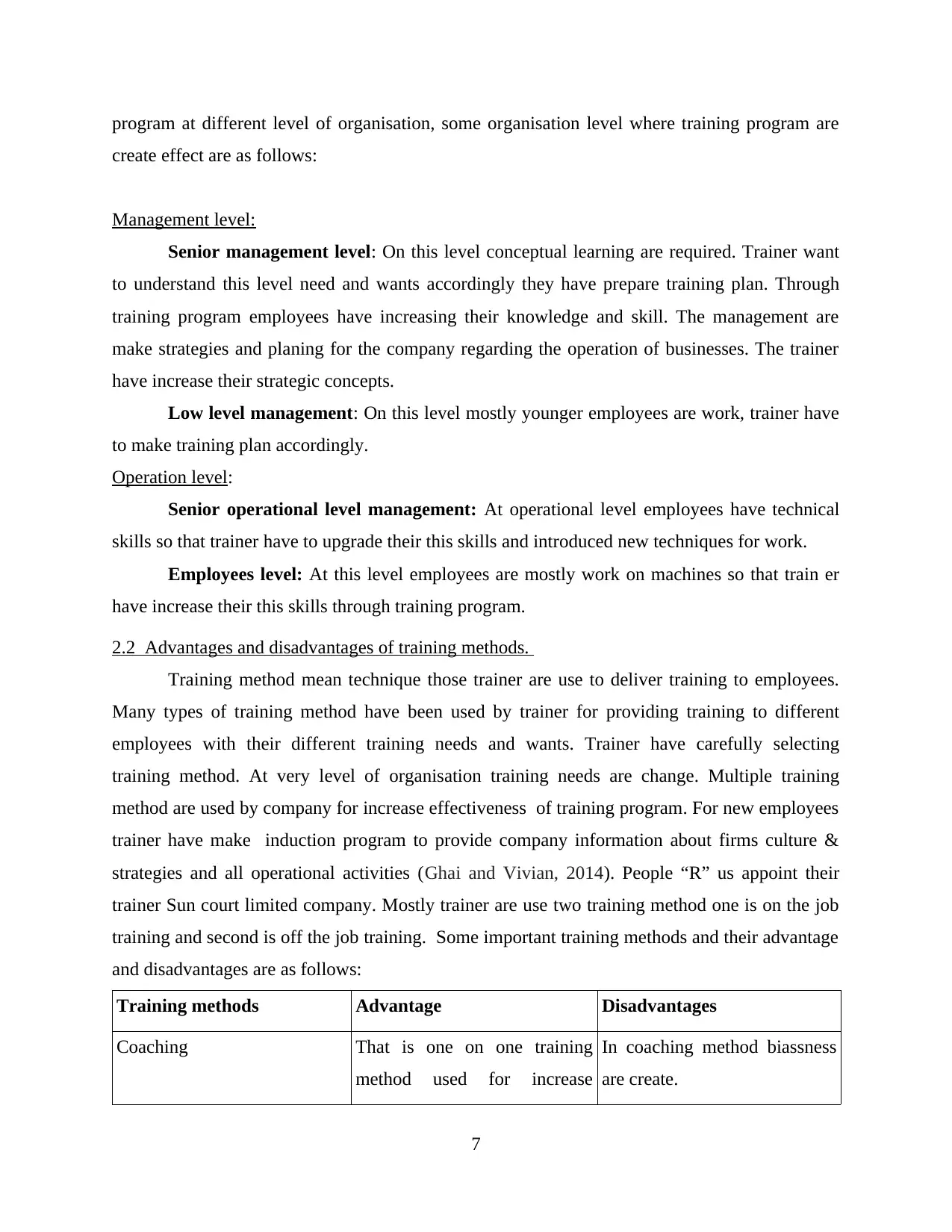
program at different level of organisation, some organisation level where training program are
create effect are as follows:
Management level:
Senior management level: On this level conceptual learning are required. Trainer want
to understand this level need and wants accordingly they have prepare training plan. Through
training program employees have increasing their knowledge and skill. The management are
make strategies and planing for the company regarding the operation of businesses. The trainer
have increase their strategic concepts.
Low level management: On this level mostly younger employees are work, trainer have
to make training plan accordingly.
Operation level:
Senior operational level management: At operational level employees have technical
skills so that trainer have to upgrade their this skills and introduced new techniques for work.
Employees level: At this level employees are mostly work on machines so that train er
have increase their this skills through training program.
2.2 Advantages and disadvantages of training methods.
Training method mean technique those trainer are use to deliver training to employees.
Many types of training method have been used by trainer for providing training to different
employees with their different training needs and wants. Trainer have carefully selecting
training method. At very level of organisation training needs are change. Multiple training
method are used by company for increase effectiveness of training program. For new employees
trainer have make induction program to provide company information about firms culture &
strategies and all operational activities (Ghai and Vivian, 2014). People “R” us appoint their
trainer Sun court limited company. Mostly trainer are use two training method one is on the job
training and second is off the job training. Some important training methods and their advantage
and disadvantages are as follows:
Training methods Advantage Disadvantages
Coaching That is one on one training
method used for increase
In coaching method biassness
are create.
7
create effect are as follows:
Management level:
Senior management level: On this level conceptual learning are required. Trainer want
to understand this level need and wants accordingly they have prepare training plan. Through
training program employees have increasing their knowledge and skill. The management are
make strategies and planing for the company regarding the operation of businesses. The trainer
have increase their strategic concepts.
Low level management: On this level mostly younger employees are work, trainer have
to make training plan accordingly.
Operation level:
Senior operational level management: At operational level employees have technical
skills so that trainer have to upgrade their this skills and introduced new techniques for work.
Employees level: At this level employees are mostly work on machines so that train er
have increase their this skills through training program.
2.2 Advantages and disadvantages of training methods.
Training method mean technique those trainer are use to deliver training to employees.
Many types of training method have been used by trainer for providing training to different
employees with their different training needs and wants. Trainer have carefully selecting
training method. At very level of organisation training needs are change. Multiple training
method are used by company for increase effectiveness of training program. For new employees
trainer have make induction program to provide company information about firms culture &
strategies and all operational activities (Ghai and Vivian, 2014). People “R” us appoint their
trainer Sun court limited company. Mostly trainer are use two training method one is on the job
training and second is off the job training. Some important training methods and their advantage
and disadvantages are as follows:
Training methods Advantage Disadvantages
Coaching That is one on one training
method used for increase
In coaching method biassness
are create.
7
Paraphrase This Document
Need a fresh take? Get an instant paraphrase of this document with our AI Paraphraser
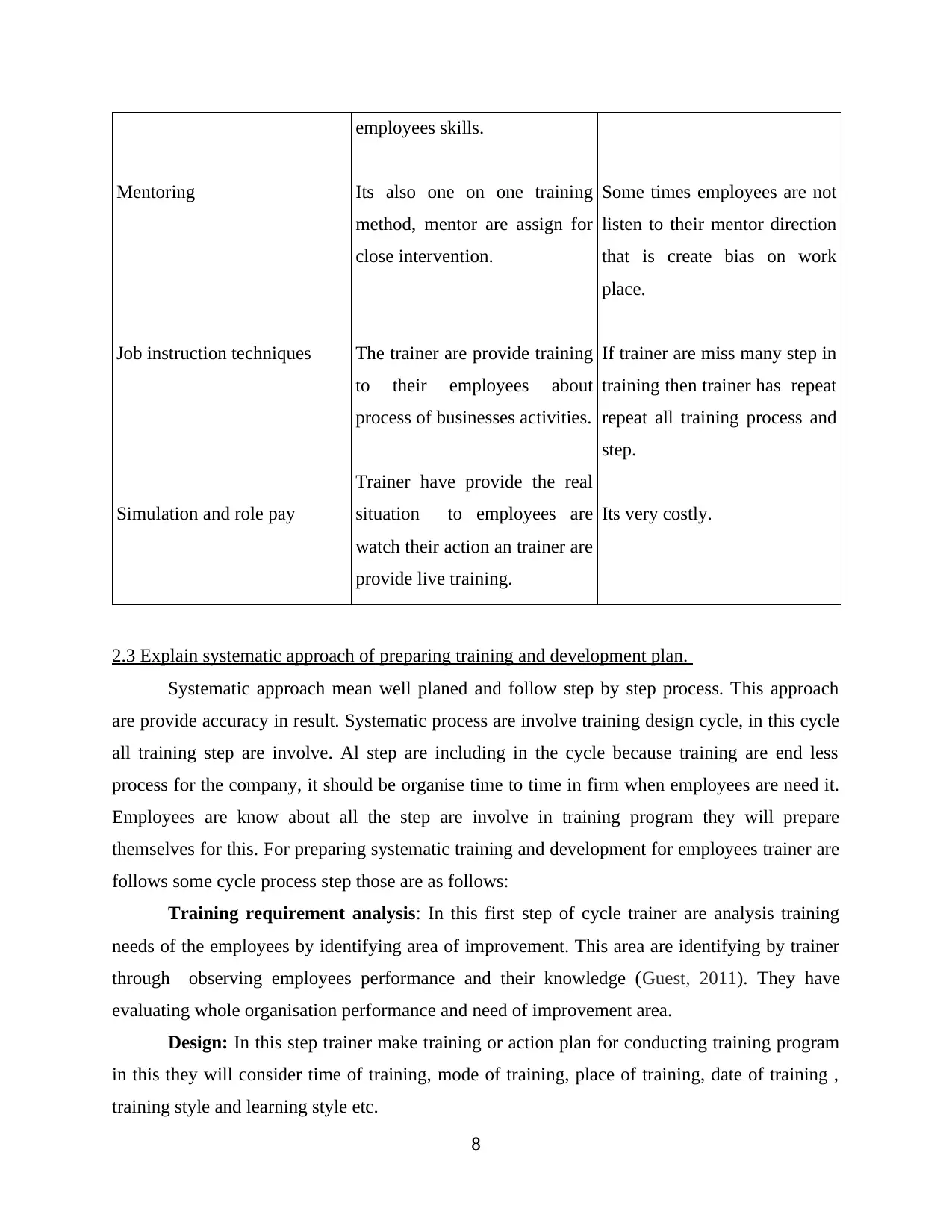
Mentoring
Job instruction techniques
Simulation and role pay
employees skills.
Its also one on one training
method, mentor are assign for
close intervention.
The trainer are provide training
to their employees about
process of businesses activities.
Trainer have provide the real
situation to employees are
watch their action an trainer are
provide live training.
Some times employees are not
listen to their mentor direction
that is create bias on work
place.
If trainer are miss many step in
training then trainer has repeat
repeat all training process and
step.
Its very costly.
2.3 Explain systematic approach of preparing training and development plan.
Systematic approach mean well planed and follow step by step process. This approach
are provide accuracy in result. Systematic process are involve training design cycle, in this cycle
all training step are involve. Al step are including in the cycle because training are end less
process for the company, it should be organise time to time in firm when employees are need it.
Employees are know about all the step are involve in training program they will prepare
themselves for this. For preparing systematic training and development for employees trainer are
follows some cycle process step those are as follows:
Training requirement analysis: In this first step of cycle trainer are analysis training
needs of the employees by identifying area of improvement. This area are identifying by trainer
through observing employees performance and their knowledge (Guest, 2011). They have
evaluating whole organisation performance and need of improvement area.
Design: In this step trainer make training or action plan for conducting training program
in this they will consider time of training, mode of training, place of training, date of training ,
training style and learning style etc.
8
Job instruction techniques
Simulation and role pay
employees skills.
Its also one on one training
method, mentor are assign for
close intervention.
The trainer are provide training
to their employees about
process of businesses activities.
Trainer have provide the real
situation to employees are
watch their action an trainer are
provide live training.
Some times employees are not
listen to their mentor direction
that is create bias on work
place.
If trainer are miss many step in
training then trainer has repeat
repeat all training process and
step.
Its very costly.
2.3 Explain systematic approach of preparing training and development plan.
Systematic approach mean well planed and follow step by step process. This approach
are provide accuracy in result. Systematic process are involve training design cycle, in this cycle
all training step are involve. Al step are including in the cycle because training are end less
process for the company, it should be organise time to time in firm when employees are need it.
Employees are know about all the step are involve in training program they will prepare
themselves for this. For preparing systematic training and development for employees trainer are
follows some cycle process step those are as follows:
Training requirement analysis: In this first step of cycle trainer are analysis training
needs of the employees by identifying area of improvement. This area are identifying by trainer
through observing employees performance and their knowledge (Guest, 2011). They have
evaluating whole organisation performance and need of improvement area.
Design: In this step trainer make training or action plan for conducting training program
in this they will consider time of training, mode of training, place of training, date of training ,
training style and learning style etc.
8
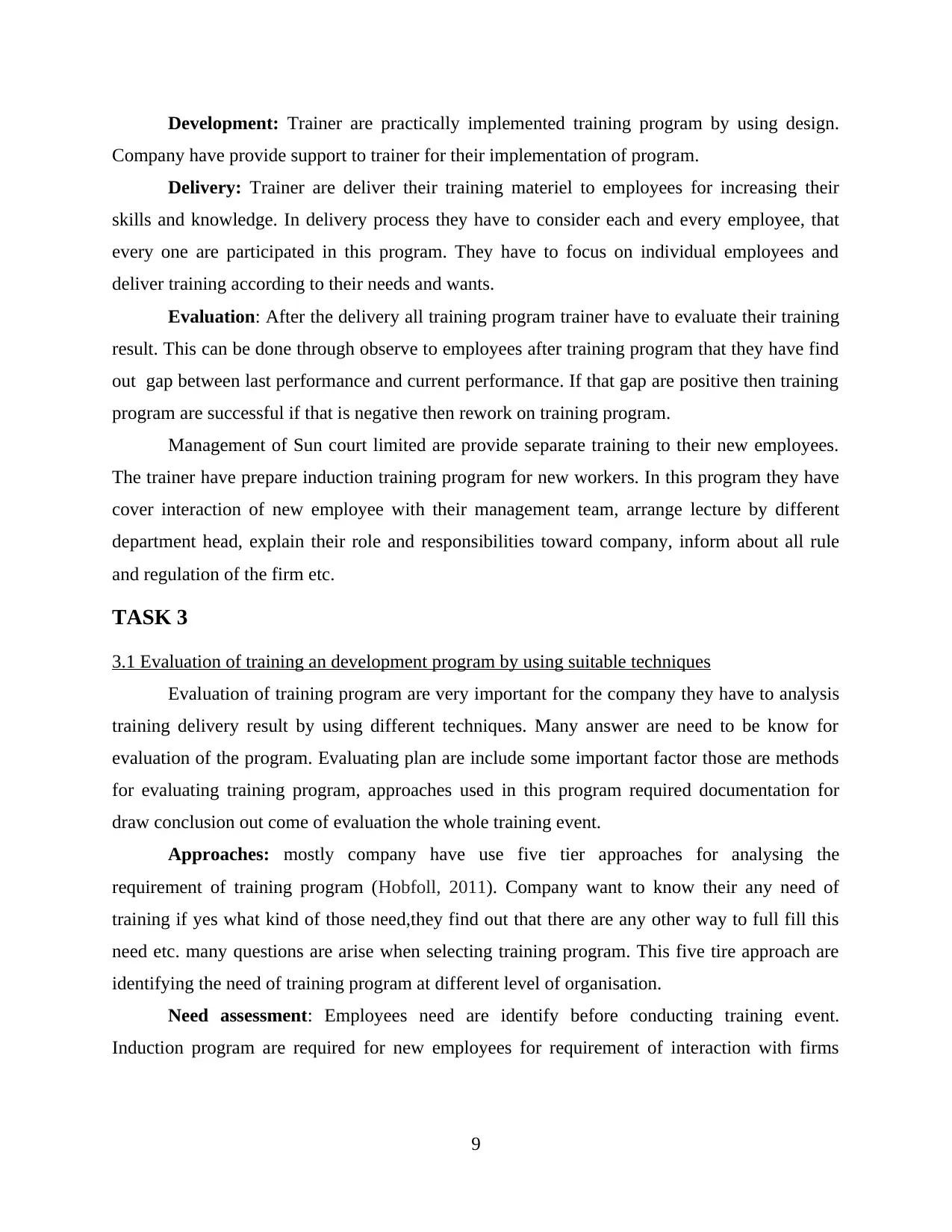
Development: Trainer are practically implemented training program by using design.
Company have provide support to trainer for their implementation of program.
Delivery: Trainer are deliver their training materiel to employees for increasing their
skills and knowledge. In delivery process they have to consider each and every employee, that
every one are participated in this program. They have to focus on individual employees and
deliver training according to their needs and wants.
Evaluation: After the delivery all training program trainer have to evaluate their training
result. This can be done through observe to employees after training program that they have find
out gap between last performance and current performance. If that gap are positive then training
program are successful if that is negative then rework on training program.
Management of Sun court limited are provide separate training to their new employees.
The trainer have prepare induction training program for new workers. In this program they have
cover interaction of new employee with their management team, arrange lecture by different
department head, explain their role and responsibilities toward company, inform about all rule
and regulation of the firm etc.
TASK 3
3.1 Evaluation of training an development program by using suitable techniques
Evaluation of training program are very important for the company they have to analysis
training delivery result by using different techniques. Many answer are need to be know for
evaluation of the program. Evaluating plan are include some important factor those are methods
for evaluating training program, approaches used in this program required documentation for
draw conclusion out come of evaluation the whole training event.
Approaches: mostly company have use five tier approaches for analysing the
requirement of training program (Hobfoll, 2011). Company want to know their any need of
training if yes what kind of those need,they find out that there are any other way to full fill this
need etc. many questions are arise when selecting training program. This five tire approach are
identifying the need of training program at different level of organisation.
Need assessment: Employees need are identify before conducting training event.
Induction program are required for new employees for requirement of interaction with firms
9
Company have provide support to trainer for their implementation of program.
Delivery: Trainer are deliver their training materiel to employees for increasing their
skills and knowledge. In delivery process they have to consider each and every employee, that
every one are participated in this program. They have to focus on individual employees and
deliver training according to their needs and wants.
Evaluation: After the delivery all training program trainer have to evaluate their training
result. This can be done through observe to employees after training program that they have find
out gap between last performance and current performance. If that gap are positive then training
program are successful if that is negative then rework on training program.
Management of Sun court limited are provide separate training to their new employees.
The trainer have prepare induction training program for new workers. In this program they have
cover interaction of new employee with their management team, arrange lecture by different
department head, explain their role and responsibilities toward company, inform about all rule
and regulation of the firm etc.
TASK 3
3.1 Evaluation of training an development program by using suitable techniques
Evaluation of training program are very important for the company they have to analysis
training delivery result by using different techniques. Many answer are need to be know for
evaluation of the program. Evaluating plan are include some important factor those are methods
for evaluating training program, approaches used in this program required documentation for
draw conclusion out come of evaluation the whole training event.
Approaches: mostly company have use five tier approaches for analysing the
requirement of training program (Hobfoll, 2011). Company want to know their any need of
training if yes what kind of those need,they find out that there are any other way to full fill this
need etc. many questions are arise when selecting training program. This five tire approach are
identifying the need of training program at different level of organisation.
Need assessment: Employees need are identify before conducting training event.
Induction program are required for new employees for requirement of interaction with firms
9
You're viewing a preview
Unlock full access by subscribing today!
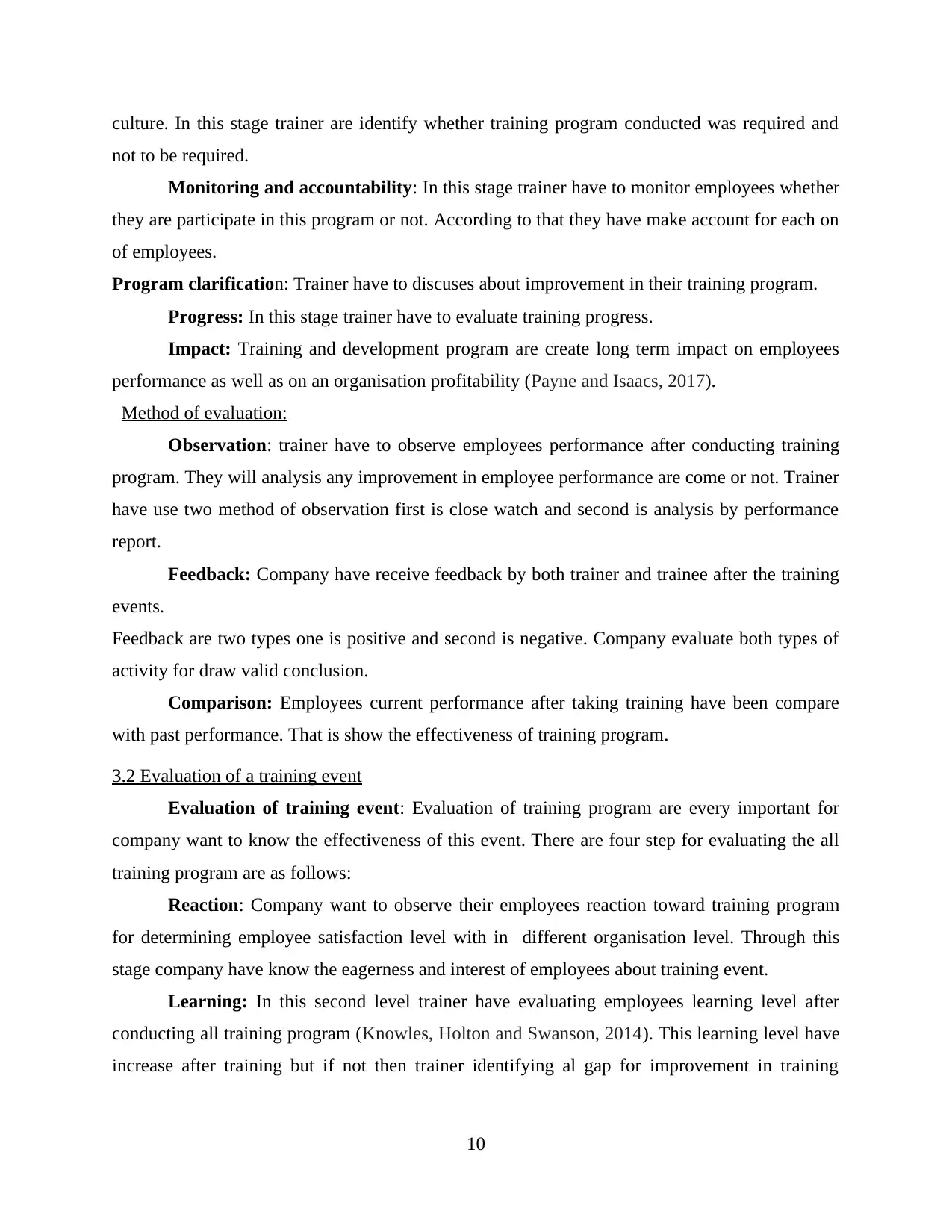
culture. In this stage trainer are identify whether training program conducted was required and
not to be required.
Monitoring and accountability: In this stage trainer have to monitor employees whether
they are participate in this program or not. According to that they have make account for each on
of employees.
Program clarification: Trainer have to discuses about improvement in their training program.
Progress: In this stage trainer have to evaluate training progress.
Impact: Training and development program are create long term impact on employees
performance as well as on an organisation profitability (Payne and Isaacs, 2017).
Method of evaluation:
Observation: trainer have to observe employees performance after conducting training
program. They will analysis any improvement in employee performance are come or not. Trainer
have use two method of observation first is close watch and second is analysis by performance
report.
Feedback: Company have receive feedback by both trainer and trainee after the training
events.
Feedback are two types one is positive and second is negative. Company evaluate both types of
activity for draw valid conclusion.
Comparison: Employees current performance after taking training have been compare
with past performance. That is show the effectiveness of training program.
3.2 Evaluation of a training event
Evaluation of training event: Evaluation of training program are every important for
company want to know the effectiveness of this event. There are four step for evaluating the all
training program are as follows:
Reaction: Company want to observe their employees reaction toward training program
for determining employee satisfaction level with in different organisation level. Through this
stage company have know the eagerness and interest of employees about training event.
Learning: In this second level trainer have evaluating employees learning level after
conducting all training program (Knowles, Holton and Swanson, 2014). This learning level have
increase after training but if not then trainer identifying al gap for improvement in training
10
not to be required.
Monitoring and accountability: In this stage trainer have to monitor employees whether
they are participate in this program or not. According to that they have make account for each on
of employees.
Program clarification: Trainer have to discuses about improvement in their training program.
Progress: In this stage trainer have to evaluate training progress.
Impact: Training and development program are create long term impact on employees
performance as well as on an organisation profitability (Payne and Isaacs, 2017).
Method of evaluation:
Observation: trainer have to observe employees performance after conducting training
program. They will analysis any improvement in employee performance are come or not. Trainer
have use two method of observation first is close watch and second is analysis by performance
report.
Feedback: Company have receive feedback by both trainer and trainee after the training
events.
Feedback are two types one is positive and second is negative. Company evaluate both types of
activity for draw valid conclusion.
Comparison: Employees current performance after taking training have been compare
with past performance. That is show the effectiveness of training program.
3.2 Evaluation of a training event
Evaluation of training event: Evaluation of training program are every important for
company want to know the effectiveness of this event. There are four step for evaluating the all
training program are as follows:
Reaction: Company want to observe their employees reaction toward training program
for determining employee satisfaction level with in different organisation level. Through this
stage company have know the eagerness and interest of employees about training event.
Learning: In this second level trainer have evaluating employees learning level after
conducting all training program (Knowles, Holton and Swanson, 2014). This learning level have
increase after training but if not then trainer identifying al gap for improvement in training
10
Paraphrase This Document
Need a fresh take? Get an instant paraphrase of this document with our AI Paraphraser
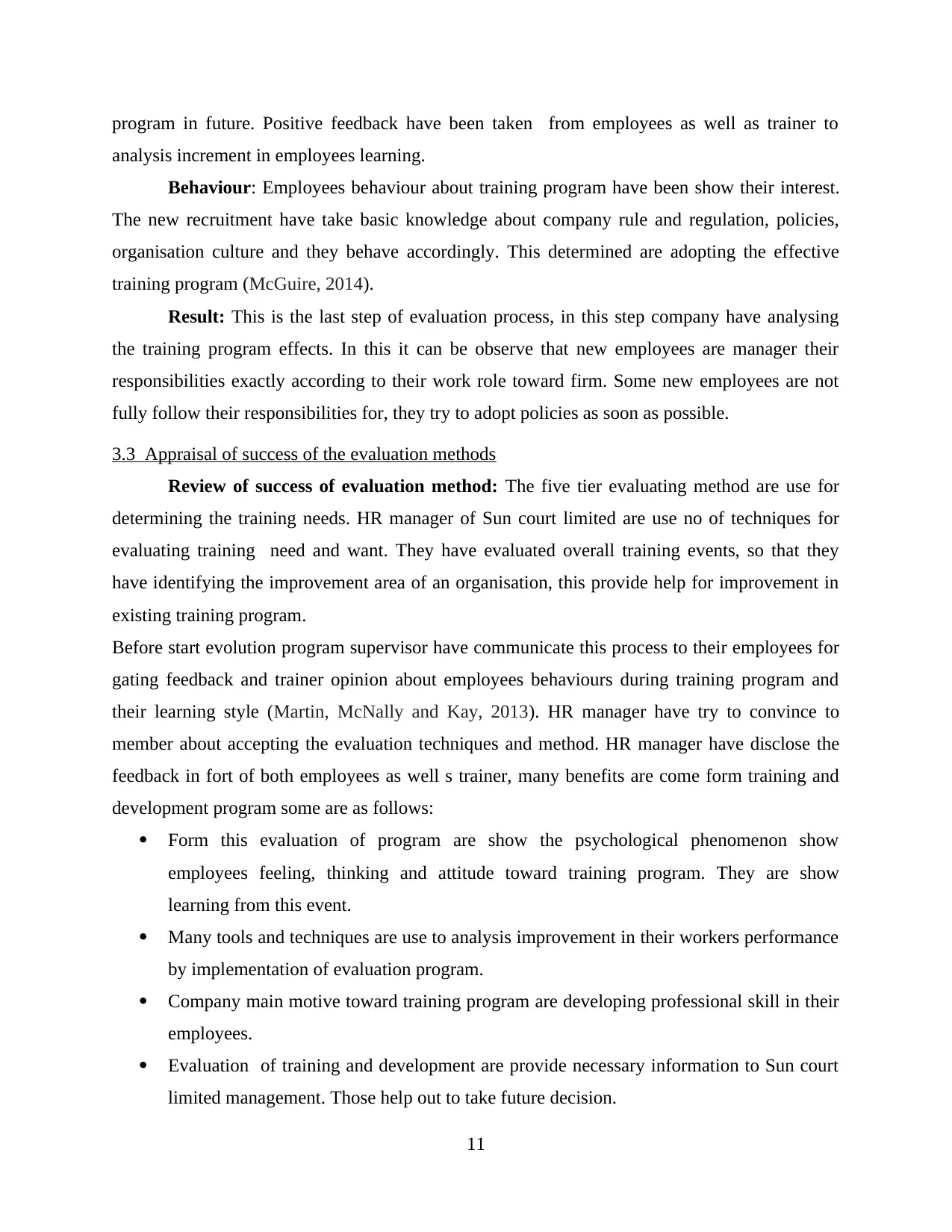
program in future. Positive feedback have been taken from employees as well as trainer to
analysis increment in employees learning.
Behaviour: Employees behaviour about training program have been show their interest.
The new recruitment have take basic knowledge about company rule and regulation, policies,
organisation culture and they behave accordingly. This determined are adopting the effective
training program (McGuire, 2014).
Result: This is the last step of evaluation process, in this step company have analysing
the training program effects. In this it can be observe that new employees are manager their
responsibilities exactly according to their work role toward firm. Some new employees are not
fully follow their responsibilities for, they try to adopt policies as soon as possible.
3.3 Appraisal of success of the evaluation methods
Review of success of evaluation method: The five tier evaluating method are use for
determining the training needs. HR manager of Sun court limited are use no of techniques for
evaluating training need and want. They have evaluated overall training events, so that they
have identifying the improvement area of an organisation, this provide help for improvement in
existing training program.
Before start evolution program supervisor have communicate this process to their employees for
gating feedback and trainer opinion about employees behaviours during training program and
their learning style (Martin, McNally and Kay, 2013). HR manager have try to convince to
member about accepting the evaluation techniques and method. HR manager have disclose the
feedback in fort of both employees as well s trainer, many benefits are come form training and
development program some are as follows:
Form this evaluation of program are show the psychological phenomenon show
employees feeling, thinking and attitude toward training program. They are show
learning from this event.
Many tools and techniques are use to analysis improvement in their workers performance
by implementation of evaluation program.
Company main motive toward training program are developing professional skill in their
employees.
Evaluation of training and development are provide necessary information to Sun court
limited management. Those help out to take future decision.
11
analysis increment in employees learning.
Behaviour: Employees behaviour about training program have been show their interest.
The new recruitment have take basic knowledge about company rule and regulation, policies,
organisation culture and they behave accordingly. This determined are adopting the effective
training program (McGuire, 2014).
Result: This is the last step of evaluation process, in this step company have analysing
the training program effects. In this it can be observe that new employees are manager their
responsibilities exactly according to their work role toward firm. Some new employees are not
fully follow their responsibilities for, they try to adopt policies as soon as possible.
3.3 Appraisal of success of the evaluation methods
Review of success of evaluation method: The five tier evaluating method are use for
determining the training needs. HR manager of Sun court limited are use no of techniques for
evaluating training need and want. They have evaluated overall training events, so that they
have identifying the improvement area of an organisation, this provide help for improvement in
existing training program.
Before start evolution program supervisor have communicate this process to their employees for
gating feedback and trainer opinion about employees behaviours during training program and
their learning style (Martin, McNally and Kay, 2013). HR manager have try to convince to
member about accepting the evaluation techniques and method. HR manager have disclose the
feedback in fort of both employees as well s trainer, many benefits are come form training and
development program some are as follows:
Form this evaluation of program are show the psychological phenomenon show
employees feeling, thinking and attitude toward training program. They are show
learning from this event.
Many tools and techniques are use to analysis improvement in their workers performance
by implementation of evaluation program.
Company main motive toward training program are developing professional skill in their
employees.
Evaluation of training and development are provide necessary information to Sun court
limited management. Those help out to take future decision.
11
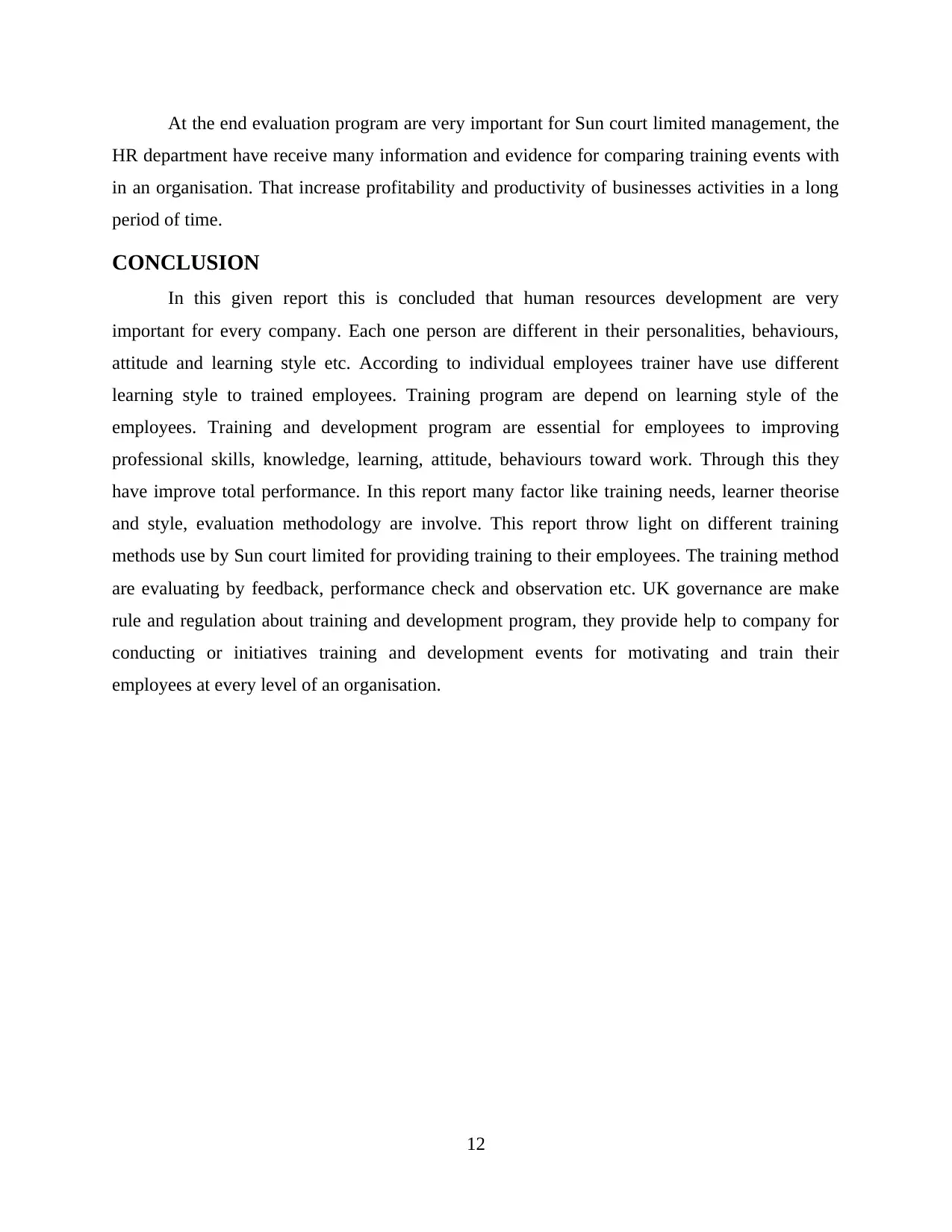
At the end evaluation program are very important for Sun court limited management, the
HR department have receive many information and evidence for comparing training events with
in an organisation. That increase profitability and productivity of businesses activities in a long
period of time.
CONCLUSION
In this given report this is concluded that human resources development are very
important for every company. Each one person are different in their personalities, behaviours,
attitude and learning style etc. According to individual employees trainer have use different
learning style to trained employees. Training program are depend on learning style of the
employees. Training and development program are essential for employees to improving
professional skills, knowledge, learning, attitude, behaviours toward work. Through this they
have improve total performance. In this report many factor like training needs, learner theorise
and style, evaluation methodology are involve. This report throw light on different training
methods use by Sun court limited for providing training to their employees. The training method
are evaluating by feedback, performance check and observation etc. UK governance are make
rule and regulation about training and development program, they provide help to company for
conducting or initiatives training and development events for motivating and train their
employees at every level of an organisation.
12
HR department have receive many information and evidence for comparing training events with
in an organisation. That increase profitability and productivity of businesses activities in a long
period of time.
CONCLUSION
In this given report this is concluded that human resources development are very
important for every company. Each one person are different in their personalities, behaviours,
attitude and learning style etc. According to individual employees trainer have use different
learning style to trained employees. Training program are depend on learning style of the
employees. Training and development program are essential for employees to improving
professional skills, knowledge, learning, attitude, behaviours toward work. Through this they
have improve total performance. In this report many factor like training needs, learner theorise
and style, evaluation methodology are involve. This report throw light on different training
methods use by Sun court limited for providing training to their employees. The training method
are evaluating by feedback, performance check and observation etc. UK governance are make
rule and regulation about training and development program, they provide help to company for
conducting or initiatives training and development events for motivating and train their
employees at every level of an organisation.
12
You're viewing a preview
Unlock full access by subscribing today!
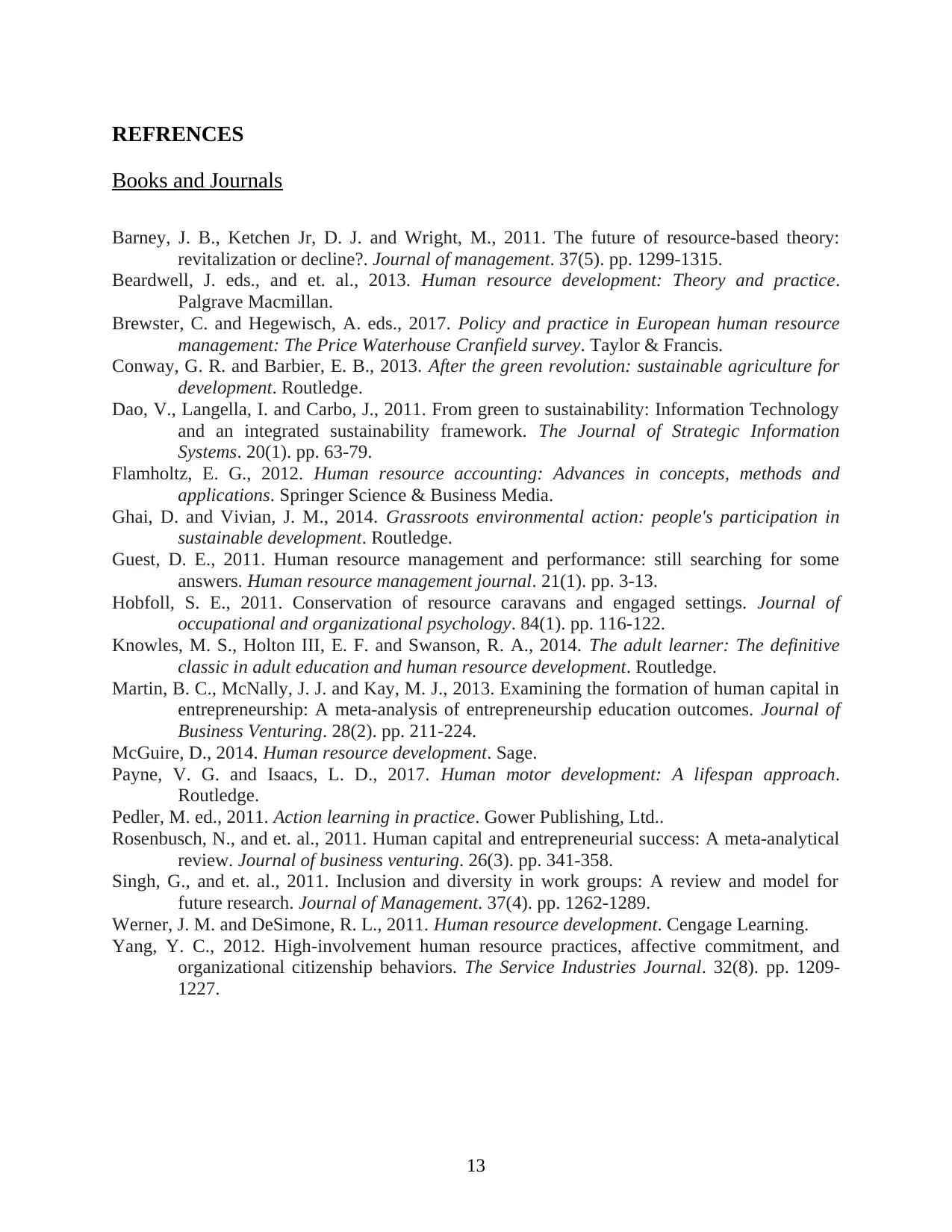
REFRENCES
Books and Journals
Barney, J. B., Ketchen Jr, D. J. and Wright, M., 2011. The future of resource-based theory:
revitalization or decline?. Journal of management. 37(5). pp. 1299-1315.
Beardwell, J. eds., and et. al., 2013. Human resource development: Theory and practice.
Palgrave Macmillan.
Brewster, C. and Hegewisch, A. eds., 2017. Policy and practice in European human resource
management: The Price Waterhouse Cranfield survey. Taylor & Francis.
Conway, G. R. and Barbier, E. B., 2013. After the green revolution: sustainable agriculture for
development. Routledge.
Dao, V., Langella, I. and Carbo, J., 2011. From green to sustainability: Information Technology
and an integrated sustainability framework. The Journal of Strategic Information
Systems. 20(1). pp. 63-79.
Flamholtz, E. G., 2012. Human resource accounting: Advances in concepts, methods and
applications. Springer Science & Business Media.
Ghai, D. and Vivian, J. M., 2014. Grassroots environmental action: people's participation in
sustainable development. Routledge.
Guest, D. E., 2011. Human resource management and performance: still searching for some
answers. Human resource management journal. 21(1). pp. 3-13.
Hobfoll, S. E., 2011. Conservation of resource caravans and engaged settings. Journal of
occupational and organizational psychology. 84(1). pp. 116-122.
Knowles, M. S., Holton III, E. F. and Swanson, R. A., 2014. The adult learner: The definitive
classic in adult education and human resource development. Routledge.
Martin, B. C., McNally, J. J. and Kay, M. J., 2013. Examining the formation of human capital in
entrepreneurship: A meta-analysis of entrepreneurship education outcomes. Journal of
Business Venturing. 28(2). pp. 211-224.
McGuire, D., 2014. Human resource development. Sage.
Payne, V. G. and Isaacs, L. D., 2017. Human motor development: A lifespan approach.
Routledge.
Pedler, M. ed., 2011. Action learning in practice. Gower Publishing, Ltd..
Rosenbusch, N., and et. al., 2011. Human capital and entrepreneurial success: A meta-analytical
review. Journal of business venturing. 26(3). pp. 341-358.
Singh, G., and et. al., 2011. Inclusion and diversity in work groups: A review and model for
future research. Journal of Management. 37(4). pp. 1262-1289.
Werner, J. M. and DeSimone, R. L., 2011. Human resource development. Cengage Learning.
Yang, Y. C., 2012. High-involvement human resource practices, affective commitment, and
organizational citizenship behaviors. The Service Industries Journal. 32(8). pp. 1209-
1227.
13
Books and Journals
Barney, J. B., Ketchen Jr, D. J. and Wright, M., 2011. The future of resource-based theory:
revitalization or decline?. Journal of management. 37(5). pp. 1299-1315.
Beardwell, J. eds., and et. al., 2013. Human resource development: Theory and practice.
Palgrave Macmillan.
Brewster, C. and Hegewisch, A. eds., 2017. Policy and practice in European human resource
management: The Price Waterhouse Cranfield survey. Taylor & Francis.
Conway, G. R. and Barbier, E. B., 2013. After the green revolution: sustainable agriculture for
development. Routledge.
Dao, V., Langella, I. and Carbo, J., 2011. From green to sustainability: Information Technology
and an integrated sustainability framework. The Journal of Strategic Information
Systems. 20(1). pp. 63-79.
Flamholtz, E. G., 2012. Human resource accounting: Advances in concepts, methods and
applications. Springer Science & Business Media.
Ghai, D. and Vivian, J. M., 2014. Grassroots environmental action: people's participation in
sustainable development. Routledge.
Guest, D. E., 2011. Human resource management and performance: still searching for some
answers. Human resource management journal. 21(1). pp. 3-13.
Hobfoll, S. E., 2011. Conservation of resource caravans and engaged settings. Journal of
occupational and organizational psychology. 84(1). pp. 116-122.
Knowles, M. S., Holton III, E. F. and Swanson, R. A., 2014. The adult learner: The definitive
classic in adult education and human resource development. Routledge.
Martin, B. C., McNally, J. J. and Kay, M. J., 2013. Examining the formation of human capital in
entrepreneurship: A meta-analysis of entrepreneurship education outcomes. Journal of
Business Venturing. 28(2). pp. 211-224.
McGuire, D., 2014. Human resource development. Sage.
Payne, V. G. and Isaacs, L. D., 2017. Human motor development: A lifespan approach.
Routledge.
Pedler, M. ed., 2011. Action learning in practice. Gower Publishing, Ltd..
Rosenbusch, N., and et. al., 2011. Human capital and entrepreneurial success: A meta-analytical
review. Journal of business venturing. 26(3). pp. 341-358.
Singh, G., and et. al., 2011. Inclusion and diversity in work groups: A review and model for
future research. Journal of Management. 37(4). pp. 1262-1289.
Werner, J. M. and DeSimone, R. L., 2011. Human resource development. Cengage Learning.
Yang, Y. C., 2012. High-involvement human resource practices, affective commitment, and
organizational citizenship behaviors. The Service Industries Journal. 32(8). pp. 1209-
1227.
13
1 out of 16
Related Documents
Your All-in-One AI-Powered Toolkit for Academic Success.
+13062052269
info@desklib.com
Available 24*7 on WhatsApp / Email
![[object Object]](/_next/static/media/star-bottom.7253800d.svg)
Unlock your academic potential
© 2024 | Zucol Services PVT LTD | All rights reserved.





